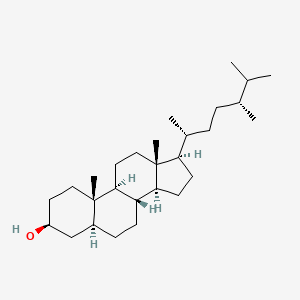| Authors | Title | Published | Journal | PubMed Link |
|---|---|---|---|---|
| Weingärtner O et al. | Differential effects on inhibition of cholesterol absorption by plant stanol and plant sterol esters in apoE-/- mice. | 2011 | Cardiovasc. Res. | pmid:21257611 |
| Lin Y et al. | Triterpenic Acids Present in Hawthorn Lower Plasma Cholesterol by Inhibiting Intestinal ACAT Activity in Hamsters. | 2011 | Evid Based Complement Alternat Med | pmid:19228775 |
| Lin DS et al. | The effects of sterol structure upon sterol esterification. | 2010 | Atherosclerosis | pmid:19679306 |
| Gylling H et al. | Very high plant stanol intake and serum plant stanols and non-cholesterol sterols. | 2010 | Eur J Nutr | pmid:19774436 |
| Chen Q et al. | Dietary phytosterols and phytostanols decrease cholesterol levels but increase blood pressure in WKY inbred rats in the absence of salt-loading. | 2010 | Nutr Metab (Lond) | pmid:20637058 |
| Méndez-González J et al. | Disodium ascorbyl phytostanol phosphate (FM-VP4), a modified phytostanol, is a highly active hypocholesterolaemic agent that affects the enterohepatic circulation of both cholesterol and bile acids in mice. | 2010 | Br. J. Nutr. | pmid:19822032 |
| Schrøder M et al. | Effect of rapeseed oil-derived plant sterol and stanol esters on atherosclerosis parameters in cholesterol-challenged heterozygous Watanabe heritable hyperlipidaemic rabbits. | 2009 | Br. J. Nutr. | pmid:19772679 |
| Weingärtner O et al. | Controversial role of plant sterol esters in the management of hypercholesterolaemia. | 2009 | Eur. Heart J. | pmid:19158117 |
| Chen Q et al. | Dietary phytosterols and phytostanols alter the expression of sterol-regulatory genes in SHRSP and WKY inbred rats. | 2009 | Ann. Nutr. Metab. | pmid:19851062 |
| Jia X et al. | Co-administration of berberine and plant stanols synergistically reduces plasma cholesterol in rats. | 2008 | Atherosclerosis | pmid:18430428 |
Campestanol
Campestanol is a lipid of Sterol Lipids (ST) class. The involved functions are known as Oxidation. The related lipids are campestanol, Sterols, campesterol and 6-oxocampestanol.
Cross Reference
Introduction
To understand associated biological information of Campestanol, we collected biological information of abnormalities, associated pathways, cellular/molecular locations, biological functions, related genes/proteins, lipids and common seen animal/experimental models with organized paragraphs from literatures.
What diseases are associated with Campestanol?
There are no associated biomedical information in the current reference collection.
No disease MeSH terms mapped to the current reference collection.
PubChem Associated disorders and diseases
What pathways are associated with Campestanol
Lipid pathways are not clear in current pathway databases. We organized associated pathways with Campestanol through full-text articles, including metabolic pathways or pathways of biological mechanisms.
Related references are published most in these journals:
| Pathway name | Related literatures |
|---|
PubChem Biomolecular Interactions and Pathways
Link to PubChem Biomolecular Interactions and PathwaysWhat cellular locations are associated with Campestanol?
There are no associated biomedical information in the current reference collection.
What functions are associated with Campestanol?
Related references are published most in these journals:
| Function | Cross reference | Weighted score | Related literatures |
|---|
What lipids are associated with Campestanol?
Related references are published most in these journals:
| Lipid concept | Cross reference | Weighted score | Related literatures |
|---|
What genes are associated with Campestanol?
There are no associated biomedical information in the current reference collection.
What common seen animal models are associated with Campestanol?
There are no associated biomedical information in the current reference collection.
